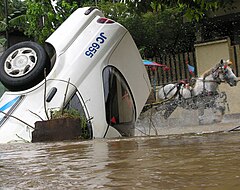2007 Jakarta flood
 A Jakarta taxi submerged by flooded water. | |
| Date | 2 February–12 February 2007 |
|---|---|
| Location | Jakarta, West Java, Banten |
| Deaths | 80 |
| Property damage | $400 million[1] |
The 2007 Jakarta flood was a major flood in Jakarta, the capital of Indonesia and affected several other areas around the city, such as West Java and Banten. The flood, beginning on February 2, 2007 was a result of heavy rain, deforestation in areas south of the city, and waterways clogged with debris.[2] The flood is considered the worst in the last three centuries, including the 1996 and 2002 Jakarta floods, which killed 10 and 25 people respectively.[3]
The final official death toll was 80.[4]
Causes
Meteorological
The most significant reason of the disaster is the high rate of rain, since the rainy season in Indonesia starts in December and ends in March. In 2007, the rain intensity reached its peak in February, with the greatest intensity towards the end of the month.[5]
Geographical
Uncontrolled population growth in urban areas, poor land use planning, and the lack of understanding among city residents and government about floods and its disaster risk are key factors in Jakarta's situation.[6] Eventually, water flowing into Jakarta overflows some of the city's flood control systems and causes devastation in these areas.
Impact
The flood affected 80 separate regions in and around Jakarta, and over 70,000 homes were flooded, resulting in the displacement of some 500,000 people.[7][8] There was a high level of illness, with 1,066 patients treated by hospitals due to diarrhea and 329 due to dengue fever.[7] The flood has caused Rp 8 trillion (US$879.12 million) in losses.[9] Approximately 190,000 people were affected by flood related illnesses.[10] The nature of the flood in which it extends from riverbanks to surrounding areas has caused the lower-class communities, many of which live on the riverbanks themselves in wooden houses, to take the strongest impact of the flood.
Aid
This article needs to be updated. (January 2014) |
HOPE worldwide distributed 5 metric ton (11,000 lbs) of food, water, medicines, clean up kits to 10,000 people.[7][11] As of March 7, another 5 metric tons had arrived in Jakarta ready for distribution.[7] The total aid cost is expected to be $239,556 to benefit over 55,000 people.[7] So far, 10% has been committed by organisations such as McDonald's, Heart to Heart International and IOM.[7]
See also
References
- ^ "Jakarta Flood Insurance Claims Seen At US$400 Million". Bernama. Malaysian National News. 2007-02-08. Archived from the original on 2007-09-29. Retrieved 2007-03-08.
- ^ Deutsch, Anthony (2007-02-07). "Death Toll from Jakarta Flood Reaches 50". Associated Press Writer. CBN News. Archived from the original on 12 February 2007. Retrieved 2007-03-08.
- ^ Yos, Rizal S; Untung Widyanto (2007-02-12). "Floodwaters back in Jakarta". Tempo Magazine. Archived from the original on 2012-12-18. Retrieved 2007-03-08.
- ^ "2007 Global Register of Major Flood Events". Archived from the original on 22 September 2019. Retrieved 8 May 2014.
- ^ "Jakarta flood victims could face more rain, illness". Relief Web. 2007-02-16. Retrieved 2007-03-08.
- ^ "Flood preparedness initiatives of high-risk communities of Jakarta" (PDF). Asian Disaster Preparedness Center. Retrieved 8 May 2014.
- ^ a b c d e f Jakarta Flood Disaster Relief - Progress Report - www.standardnewswire.com - Obtained March 11, 2007.
- ^ "2007 Global Register of Major Flood Events". Archived from the original on 22 September 2019. Retrieved 8 May 2014.
- ^ Moving squatters to apartments too good to be true - The Jakarta Post - Obtained March 11, 2007.
- ^ 190,000 sick after Jakarta flood - Herald Sun - Obtained March 11, 2007.
- ^ "Jakarta Flood Disaster Relief - Progress Report, 22 February, 2007". HOPE worldwide. Archived from the original on 19 February 2007. Retrieved 2007-03-11.
